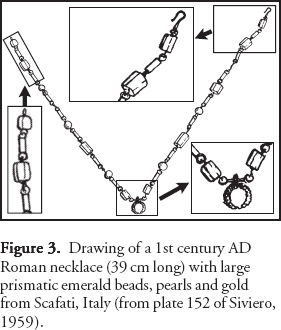Archaeological Geology of the World's First Emerald Mine
James A. HarrellProfessor of Geology, Department of Earth, Ecological and Environmental Sciences, The University of Toledo, 2801 West Bancroft St.Toledo, Ohio 43606-3390, USA
james.harrell@utoledo.edu
Accepted as revised 5 February 2004
ABSTRACT
Emerald, a green transparent variety of beryl, was one of the most highly prized gemstones in antiquity. The earliest known emerald mine is located in the mountain valley of Wadi Sikait in Egypt's Eastern Desert, where mining probably began toward the end of the Ptolemaic period in the first century BC. Most of the mining activity, however, dates to the Roman and Byzantine periods, from the late first century BC through the sixth century AD. The Romans referred to emerald as smaragdus and named the Sikait region Mons Smaragdus or Emerald Mountain. An archaeological geology survey of Wadi Sikait was undertaken for the purpose of mapping the distribution of ancient mine workings, deducing the ancient mining methods, and describing the geological occurrence of emerald. It was found that emerald and other green beryls occur within the contact zone between phlogopite schist and intrusive quartz and pegmatite veins. The workings, which were excavated in the softer phlogopite schist with flat-edged chisels and pointed picks, are mostly shallow, open-cut trenches that follow the quartz/ pegmatite veins. Some workings continue as much as 100 m underground and are still largely unexplored. It is noteworthy that the geological occur-rence of beryl in Wadi Sikait, the world's oldest emerald mine, is essentially the same as for the world's newest emerald discovery at Regal Ridge in Canada's Yukon Territory.RÉSUMÉ
L'émeraude qui est une variété de béryl vert transparent, était l'une des pierres précieuses les plus prisées dans l'Antiquité. La plus vieille mine d'émeraude connue est située dans la vallée de montagne de Wadi Sikait dans le désert oriental de l'Égypte, où l'extraction a probablement débutée vers la fin de la période ptolémaïque durantle premier siècle A.C. Cependant, le gros des travaux d'extraction date des périodes romaines et byzantines, de la fin du premier siècle avant J.C. jusqu'au sixième siècle après J.C. Les Romains utilisaient le mot smaragdus pour désigner l'émeraude et désignait la région de Sikait par l'expression Mons Smaragdus ou la montagne d'émeraude. Une étude de géologie archéologique de Wadi Sikait a été entreprise dans le but de cartographier les anciens sites d'extraction, d'en déduire les anciennes méthodes d'extraction utilisées et de circonscrire la distribution des gisements d'émeraude. On a découvert que les gisements d'émeraude et autres béryls verts sont localisés dans la zone de contact séparant une zone de schistes à phlogopite et de veines intrusives de quartz, d'une zone de pegmatites. Les excavations pratiquées dans la formation plus tendre du schiste à phlogopite à l'aide de ciseaux à pointe aplatie et de pics pointus, sont peu profondes pour la plupart, et forment des tranchées à ciel ouvert qui longent les zones de veines de quartz et de pegmatites. Certaines d'entre-elles qui se prolongent en soussol jusqu'à 100 m de profondeur sont peu explorées. Il est intéressant de noter que le cadre géologique du béryl de Wadi Sikait, la plus vieille mine d'émeraude au monde, est essentiellement le même que celui du plus récent gisement découvert à Regal Ridge dans les Territoires du Yukon au Canada.
INTRODUCTION
1 The study of ancient quarries and mines lies at the interface of geology and archaeology. It is one aspect of the broader discipline of ‘ archaeological geology' or, as it is also known, ‘ geoarchaeology' (Herz and Garrison, 1998; Rapp and Hill, 1998). Simply defined, archaeological geology is the application of geological principles and methods to archaeological objects and sites. In ancient Egypt, as with most other early civilizations, much of what remains consists of stone. There are building stones for temples and pyramids; ornamental stones for vessels, stelae, sarcophagi, statues and other sculptures; and precious stones for jewelry. The archaeological geologist may investigate not only the petrology and uses of these stones, but also the quarries and mines that supplied them, including their layout and operation, extraction and transport technologies, and geologic setting. For Egypt, the study of archaeological stones is well advanced (e.g., Aston et al., 2000; for further information on the quarries and mines see the author's web site at http://www.eeescience.utoledo.edu/egypt/).
2 As an example of the application of archaeological geology, the present paper looks at emerald mining in ancient Egypt. This review also serves to provide a historical perspective on Canada's own emerald deposit on Regal Ridge in the Pelly Mountain range (near Finlayson Lake) of southeast Yukon Territory. Emeralds were discovered here in 1998 on land owned by Expatriate Resources Ltd. of Vancouver, BC and the property is now being developed by True North Gems Inc., also of Vancouver (Groat et al., 2002). Regal Ridge is the world's youngest emerald discovery, but the world's first emerald mine was in Egypt's Wadi Sikait (Fig. 1,2). The word ‘ wadi' means ‘ valley' in Arabic and ‘ Sikait' is a Bedouin corruption of the ancient name for the site, ‘ Senskete' or ‘ Senskis.'
Figure 1. Egypt showing the location of Wadi Sikait.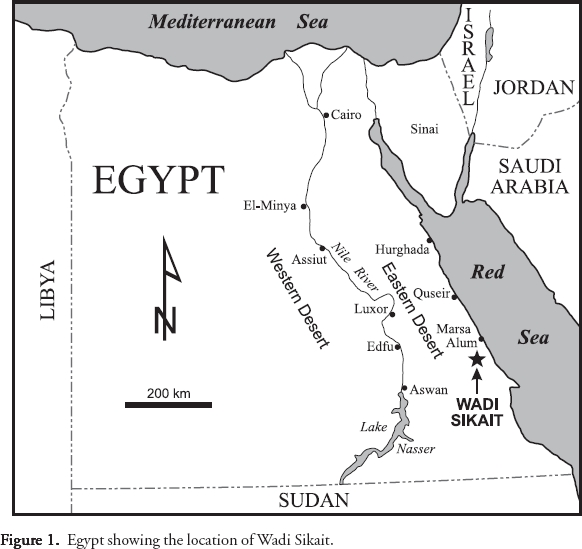
Display large image of Figure 1
3 Egypt was probably the only source of emerald and other green beryl for the ancient civilizations of Europe and the Mediterranean region. Although it has been suggested that the emerald deposit at Habachtal near Salzburg, Austria was worked as early as the Roman period, there is no conclusive evidence that it was known prior to the Middle Ages (Sinkankas, 1981, p. 371-377). However, Giuliani et al. (1998, 2000) have shown that the green beryls from Egypt and Austria are distinguishable by their oxygen-isotopic composition, and such testing, if applied to Roman jewelry, may yet reveal Habachtal's true historical significance.
4 Egyptian emerald mining occurred not only in Wadi Sikait but also at several other sites within 15 km of this valley, including Gebel Zabara to the northwest, Wadi Nugrus and Wadi Abu Rusheid to the west, Wadi Umm Kabu and Wadi Umm Debaa to the southeast, and Wadi Gimal to the southwest. Mining began first in Wadi Sikait sometime during the Ptolemaic period (late 4th through mid-1st centuries BC) with most of the activity occurring in the subsequent Roman (late 1st century BC through 4th century AD) and Early Byzantine (5th through early 6th centuries AD) periods. All the other mining sites are strictly Roman-Byzantine or Islamic (mid-6th century AD onward) in date. Beryl mining ceased in Egypt with Spain's discovery of superior-quality Colombian emeralds in the 16th century AD. It is commonly reported in the literature (e.g., Giuliani et al., 2000, p. 631) that emeralds were used in Egypt as early as the 18th dynasty (16th through 14th centuries BC) of the New Kingdom. This claim, however, is based on the misidentification by archaeologists of amazonite (a green variety of microcline) as emerald (Lucas and Harris, 1962, p. 389-390). The earliest unequivocal evidence for emerald mining in Egypt dates to Ptolemaic times, and even for this period the evidence is scant. It was the Romans who were primarily responsible for developing the mines, and it was they who gave the mining district its ancient name, Mons Smaragdus or ‘ Emerald Mountain'.
EMERALD AND OTHER BERYLS
5 Beryl is a beryllium alumino-silicate mineral with the chemical formula Be3Al2(Si6O18). Ordinary beryl is colourless but the presence of various trace impurities gives the gemstone varieties of this mineral their distinctive colours: green emerald, blue to bluish-green aquamarine, pink morganite, red bixbite, and yellow to yellowish-orange heliodor (Sinkankas, 1981, p. 206-235). Beryl almost always occurs as elongated crystals with a hexagonal cross-section. It has a Mohs scratch hardness of 7.5-8, which is exceeded by only a few other gemstones such as chrysoberyl at 8.5, ruby and sapphire corundum at 9, and diamond at 10. Although highly resistant to grinding and cutting, beryl does have a weakly developed basal cleavage. Ancient stonecutters could thus cleave it perpendicular to the crystal axis to produce hexagonal prisms of any desired length.
6 The name ‘ beryl' comes from the Roman naturalist Pliny the Elder who, writing in the 1st century AD, used beryllus to refer to a variety of minerals having long, prismatic crystals with hexagonal cross-sections. His smaragdus included the Egyptian beryl among other green stones, but he also recognized its relationship with beryllus: "many people consider the nature of berulli to be similar to, if not identical with, that of smaragdi" (Pliny's Natural History 37.16-20 in Eichholz, 1962,p. 212-227; Healy, 1999, p. 202-203, 241-245). The modern name ‘ emerald' is derived from the ancient smaragdus, a word that can be traced back at least as far as the late 4th or early 3rd century BC when it was used by the Greek writer Theophrastus as a catchall for green gemstones (Theophrastus' On Stones 23-27 in Caley and Richards, 1956, p. 50-51, 97-109). The Egyptian green beryl, however, was almost certainly unknown to him. The first mention of beryl (smaragdos) mining in Egypt was by the Greek geographer Strabo about 24 BC (Strabo's Geography 17.1.45 in Jones, 1959, p. 120-121). When mining began in Wadi Sikait is not known precisely but, given the almost total absence of green beryl in Ptolemaic jewelry, it must have been late in the Ptolemaic period and probably not much before Strabo wrote about it.
Figure 2. Topographical-geographical map of the Wadi Sikait area showing the extent of beryl mining.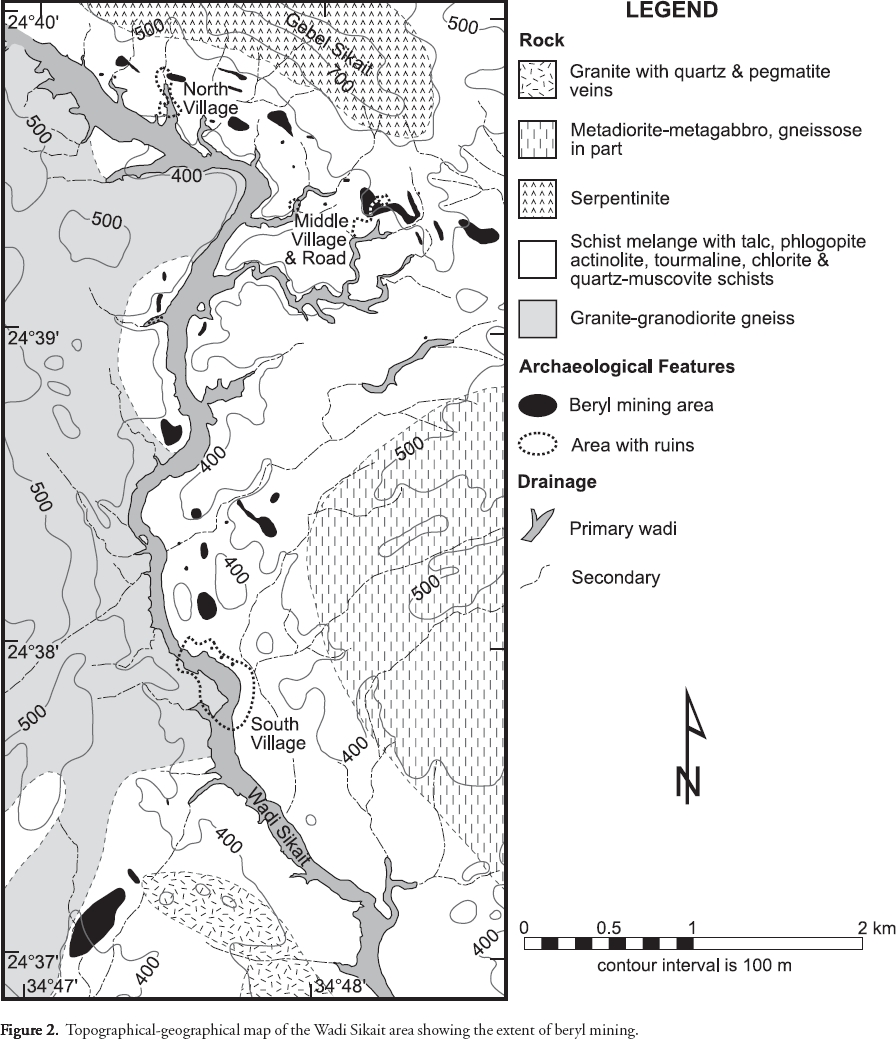
Display large image of Figure 2
7 True emerald has a bright, uniform, medium to dark green colour and is transparent. Beryls of this quality are very rare not only in Wadi Sikait but throughout the surrounding beryl-mining region. The Egyptian green beryl almost always has a pale colour and a cloudy translucency (due to abundant fluid inclusions), and it also commonly contains minute mineral inclusions (usually phlogopite or actinolite, or their weathered clay-mineral equivalents). It is ironic, therefore, that Egypt's famous ‘ emerald mines' produced very few true emeralds.
8 The poor quality of Egyptian green beryl has been attested to repeatedly in both the ancient and modern literature (for a partial summary see Sinkankas, 1981, p. 542-548). For example, Pliny the Elder complained that the "Ethiopian [i.e., Egyptian] smaragdus is … rarely flawless or uniform in tint" (Pliny's Natural History37.18.69 in Eichholz, 1962, p. 218-219). Although Egypt's ordinary green beryl may not have been highly esteemed by the Romans, it was still clearly much valued by them for jewelry. It was the hardest green gemstone available to them and it also had the added mystic of coming from fabled Egypt. Perhaps another appeal of beryl was its naturally faceted hexagonal prisms that mimicked the more costly cut gemstones. Unlike in recent centuries, when beryl has been ground into faceted stones, the Romans used the natural hexagonal prisms cleaved from crystals. These were either fixed into metal settings or drilled along the prism axis and strung as beads (Fig. 3).
Figure 3. Drawing of a 1st century AD Roman necklace (39 cm long) with large prismatic emerald beads, pearls and gold from Scafati, Italy (from plate 152 of Siviero, 1959).GEOLOGY OF WADI SIKAIT
Rock Units
9 Much has been written about the geology of the Wadi Sikait region (e.g., MacAlister, 1900; Hume, 1934, p. 109-125; EGSMA, 1951, p. 82-94; Basta and Zaki, 1961; El Shazly and Hassan, 1972; Hassan and El Shatoury, 1976; EGSMA, 1992, p. 31-83; and Abdalla and Mohamed, 1999). The map in Figure 2 is based on both this literature and fieldwork by the author. This is the first map of Wadi Sikait to combine topographic and geologic information, and also to show the distribution of ancient mine workings. The rock units in the map legend are listed chronologically downward from youngest to oldest. Not shown on the map are numerous diabase dikes that postdate the granite and intrude all other rock units. The schist melange also contains some small pockets of metadiorite-metagabbro as, for example, around the Middle Village. All the rock units date to the Late Proterozoic era and belong to the Pan-African Series except for the granite-granodiorite gneiss, which dates to an earlier part of the Proterozoic (Hassan and Hashad, 1990).
OCCURRENCE OF BERYL
10 The geologic occurrence of beryl in Wadi Sikait has been well described by Basta and Zaki (1961) and Abdalla and Mohamed (1999), and their findings are consistent with what is known generally about the origins of beryl deposits elsewhere (Sinkankas, 1981, p. 339-356). For green beryl to form, two relatively rare elements need to be present: beryllium and chromium. Beryllium-bearing minerals are most commonly associated with hydrothermal veins that are offshoots of silicic magma bodies. At Wadi Sikait, such a magma body produced the granite with its quartz and pegmatite veins. These veins generally vary from a few centimetresup to one metre in thickness, and have intruded all older rock units in the area. The veins are now much deformed and so commonly appear as discontinuous lenticular bands and pods. The occurrence of beryl is intimately linked with these Be-enriched veins, especially those of milky quartz, which are the most plentiful (Fig. 4).
Figure 4. Quartz vein in phlogopite schist showing traces of ancient mining.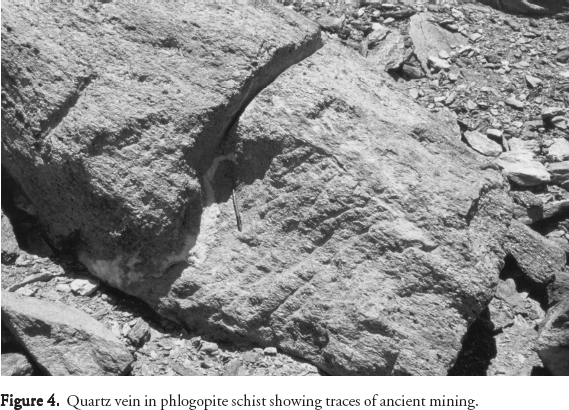
Display large image of Figure 4
11 Only minute amounts of Cr substituting for Al in the beryl crystal structure are needed to give the mineral a green colour, with darker shades produced by higher Cr concentrations. Although V can also colour beryl green, chemical analyses have shown that Cr is the colorant for Wadi Sikait beryl. Unpublished analyses of five beryl specimens from Wadi Sikait reveal Cr concentrations ranging from 150 to 1013 ppm, and averaging 552 ppm (EGSMA, 1992, Table 3.4; A. El Dougdoug, Geology Dept., Cairo University, Egypt, pers. comm.). Chromium is commonly found in rocks of mafic composition, where it occursas an impurity in mica and amphibole minerals through substitution for the Al and Fe in their crystal structures. In Wadi Sikait, these rocks are represented by phlogopite and actinolite schists in the schist melange. The actinolite schist occurs as thin sheets and lenses within the much more abundant phlogopite schist.
12 Beryl occurs mainly in the phlogopite schist and quartz/pegmatite veins, and is restricted to within tens of centimetres of their contact. It is found as individual crystals and, more often, as small clusters of crystals. Crystals can be up to 3 cm in length but most are much shorter. The beryl in the quartz/ pegmatite veins varies from colourless or white to light green but in the phlogopite schist the colour ranges from light to dark green. Given that the schist is a source of Cr, it is not surprising that this rock would have the greener beryl, including true emerald. The geologic occurrence of green beryl at Wadi Sikait is very similar to that at Canada's Regal Ridge. Here the green beryl, which is coloured by Cr, occurs within mica schist close to its contact with quartz veins spawned by a nearby granite intrusion (Groat et al., 2002, p. 1330). Contrary to what Giuliani et al. (1998, p. 513-514) claim, Wadi Sikait is not a Type II emerald deposit, where Be-bearing hydrothermal fluids permeated Cr- or V-bearing rocks along thrust faults or shear zones. Both Wadi Sikait and Regal Ridge classify as Type I emerald deposits, where Be-bearing quartz or pegmatite veins from a granitic pluton intruded Cr- or V-bearing mafic or ultramafic rocks.
ANCIENT BERYL MINING
Distribution and Types of Workings
13 Figure 2 shows the extent of beryl mining in Wadi Sikait. Also indicated on this map are three ancient mining settlements that date to the Roman and early Byzantine periods (Foster et al., in press; Sidebotham et al., 2004). The largest of these is the so-called South Village, and this is the only one where archaeological excavations have been undertaken. The buildings here, as in the other two settlements, are constructed from slabs of quartz-muscovite schist (Fig. 5, 6). The well-preserved late Roman structure in Figure 6 is probably an administrative building, but could also be a temple. The South Village is particularly notable for its rock-cut temple, which is carved out of talc schist (Fig. 7). From conservation work done on this structure, it is known that it goes back at least as early as the 1st century AD, and poorly preserved Greek and hieroglyphic inscriptions hint at an earlier Ptolemaic date. Both the quartz-muscovite and talc schists are common lithologies in the schist melange unit. The next largest settlement is the Middle Village, which is perched midway up the west side of the mountain known as Gebel Sikait (Fig. 8). Here there is also a well-preserved, ancient roadway leading down to Wadi Sikait (Fig. 9).
Figure 5. View across the South Village ruins looking south along Wadi Sikait.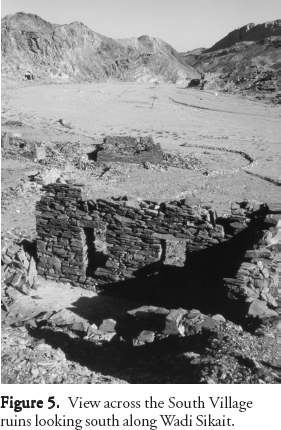
Display large image of Figure 5
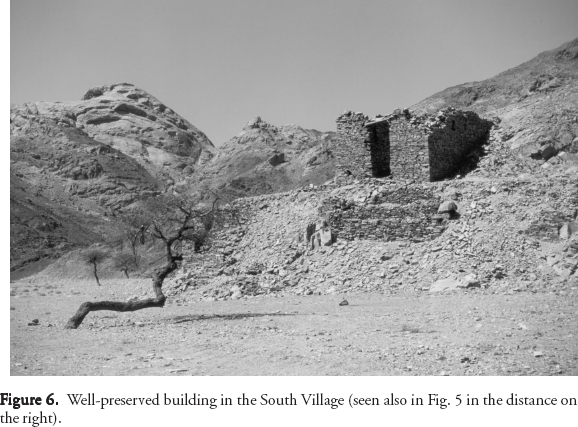
Display large image of Figure 6
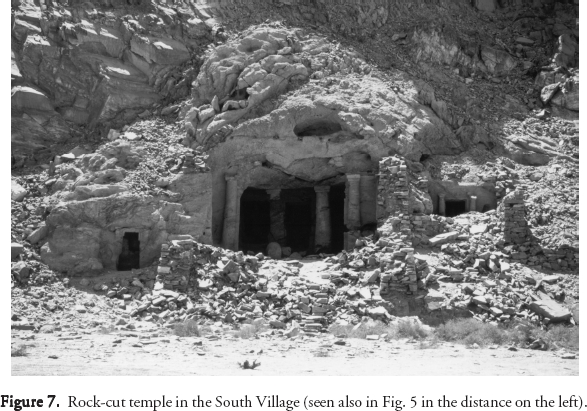
Display large image of Figure 7
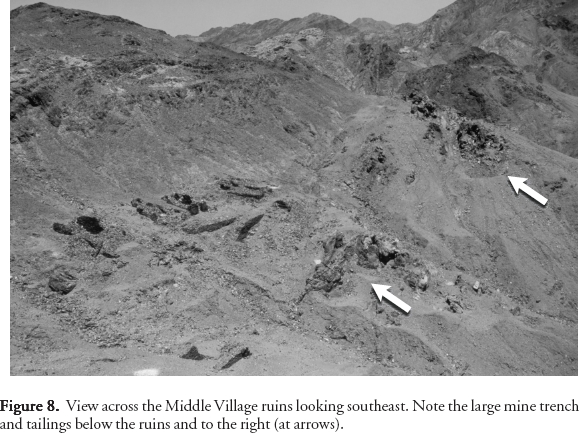
Display large image of Figure 8

Display large image of Figure 9
14 Modern prospecting and small-scale mining occurred in Wadi Sikait during the first three decades of the last century. Most traces of this activity are found around the Middle and North villages, where modern workings occur amongst the ancient ones. Past attempts at reopening the Wadi Sikait mine were all unsuccessful because of the generally poor quality and, hence, low market value of the beryl.
Prospecting and Extraction Methods
15 The ancient mine workings are mostly open-cut trenches of up to a few metres in depth. These follow the quartz/ pegmatite veins within the phlogopite schist. Many adits, shafts and tunnels, some extending over 100 m, pursue these veins deep underground. Where less than a few tens of centimetres thick, the vein together with 1-2 m of schist on both sides was removed, but for the thicker veins the schist was generally extracted along just one side. From the tool marks preserved in the schist, it is clear that the Roman miners used flat-edged chisels and, to a lesser extent, pointed picks for their excavations (Fig. 4). None of these tools, which were presumably cast from iron, have yet to be found in Wadi Sikait. Itis likely that the quartz and pegmatite veins, which are too hard for such tools, were removed by stoping with the actual digging occurring only in the much softer phlogopite schist.
16 The underground portions of the Wadi Sikait mine have not yet been studied. There are instead only a few passing comments from earlier visitors. For example, MacAlister (1900, p.544) says "the mining is of a most primitive character…the ancients simply excavated…a network of long and very tortuous passages just large enough to allow the body being dragged through, and only in a very few cases was any attempt made at …excavating the entire seam." An unpublished report from the Egyptian Geological Survey and Mining Authority (EGSMA, 1951, p. 86) provides additional details: "some mines are very elementary, the galleries are very narrow and tortuous, that one has to creep all the time…[whereas] other mines are nearly perfect; [their] walls were cleanly cut, shafts and levels were systematically dug, tunnels are [so] wide and high that it is easy to walk comfortably through…[and] steps were carved in the floor of some inclined tunnels…[and] in all cases, one can notice the presence of big pillars of country rock being left for roof support."
17 The ancient miners knew that beryl was to be found along the contact between the quartz/pegmatite veins and phlogopite schist, and so probably tested every such association where visible on the surface (Fig. 4). The fact that not all the vein-schist contacts in Wadi Sikait have been mined is an indication that either the beryl deposits are erratic in their occurrence or they were never fully exploited.
18 Although beryl occurs in the quartz/pegmatite veins, it could not have been extracted from these hard rocks without great effort and large losses of crystals through breakage. Given this as well as the generally inferior color of beryl in the veins, the ancient miners were probably interested only in the more easily worked phlogopite schist. The beryl crystals were presumably cut out of this rock with a sharp-pointed metal tool, perhaps an iron blade or burin. From the great piles of fine-grained tailings around many of the workings, it appears that the removal of beryl crystals from the schist was done at the mine site.
CONCLUSIONS
19 In Egypt's Wadi Sikait, ancient miners extracted emerald and other green beryl from the contact zone between phlogopite schist and intrusive quartz and pegmatite veins. This is essentially the same geologic occurrence as the beryl on Canada's Regal Ridge. The world's oldest emerald mine (Wadi Sikait) and youngest emerald discovery (Regal Ridge) are separated by two millennia, yet are linked by not only their similar geology but also their common purpose – to satisfy people's desire for emerald jewelry. It is through the practice of archaeological geology that such links are made.
ACKNOWLEDGEMENTS
The author wishes to thank Steven E. Sidebotham, Professor of Roman Archaeology at the University of Delaware (USA) and Director of the Wadi Sikait Project, for permission to publish the present paper. This ongoing project, for which the author is the site geologist, has been supported by grants from the National Geographic Society. Thanks are also due to A. P. Sabina and especially J.D. Greenough for their comments on an earlier draft of this paper.REFERENCES
Aston, B.G., Harrell, J.A. and Shaw, I., 2000, Stones, in Nicholson, P. T. and Shaw, I. (eds.), Ancient Egyptian Materials and Technology: University of Cambridge Press, Cambridge, UK, p. 5-77.
Abdalla, H.M. and Mohamed, F.H., 1999,Mineralogical and geochemical investigation of emerald and beryl mineralization, Pan-African Belt of Egypt – genetic and exploration aspects: Journal of African Earth Sciences, v. 28, n. 3, p. 581-598.
Basta, E.Z. and Zaki, M., 1961, Geology and mineralisation of Wadi Sikeit area, South-Eastern Desert: Journal of Geology of the United Arab Republic (later Egyptian Journal of Geology), v. 5, n. 1, p. 1-36.
Caley, E.R. and Richards, J.F.C., 1956, Theophrastus On Stones: Ohio State University Press, Columbus, Ohio, 238 p.
EGSMA, 1951, Report on the Prospecting Expedition in Wadi El Gemal Area, 1950-1951 (unpublished internal report): Egyptian Geological Survey and Mining Authority, Cairo, Egypt, 95 p.
EGSMA, 1992, Study of Gemstones in the Eastern Desert and Sinai. Chapter 3, Emerald (unpublished internal report): Egyptian Geological Survey and Mining Authority, Cairo, Egypt, p. 31-83.
Eichholz, D.E., 1962, Pliny – Natural History (Volume 10, Books 36-37): Harvard University Press, Cambridge, Massachusetts, 344 p.
El Shazly, E.M. and Hassan, M.A., 1972, Geology and radioactive mineralisation at Wadi Sikait-Wadi El Gemal area, Eastern Desert: Egyptian Journal of Geology, v. 16,n. 2, p. 201-234.
Foster, B.C., Rivard, J.-L., Sidebotham, S.E. and Cuvigny, H., in press, Survey of the emerald mines at Wadi Sikait 2000/2001 seasons (Chapter 18), in Sidebotham, S.E. and Wendrich, W.Z. (eds.), Berenike 1999-2000, Report of the 1999-2000 Excavations at Berenike (Egyptian Red Sea Coast) and the Survey of the Eastern Desert, including Excavations in Wadi Kalalat and at Sikait: Cotsen Institute of Archaeology, Los Angeles, California.
Giuliani, G., France-Lanord, C., Coget, P., Schwarz, D., Cheilletz, A., Branquet, Y., Giard, D., Martin-Izard, A., Alexandrov, P. and Piat, D.H., 1998, Oxygen isotope systematics of emerald – relevance for its origin and geological significance: Mineralium Deposita, v. 33, p. 513-519.
Giuliani, G., Chaussidan, M., Schubnel, H.-J., Piat, D.H., Rollion-Bard, C., France-Lanord, C., Giard, D., de Narvaez, D. and Rondeau, B., 2000, Oxygen isotopes and emerald trade routes since antiquity: Science, v. 287, p. 631-633.
Groat, L.A., Marshall, D.D., Giuliani, G.,Murphy, D.C., Piercey, S.J., Jambor, J.L., Mortensen, J.K., Ercit, T. S., Gault, R.A., Mattey, D.P., Schwarz, D., Maluski, H., Wise, M.A., Wengzynowski, W. and Eaton, D.W., 2002, Mineralogical and chemical study of the Regal Ridge emerald showing, southeastern Yukon: The Canadian Miner-alogist, v. 40, p. 1313-1338.
Hassan, M.A. and El Shatoury, H.M., 1976, Beryl occurrences in Egypt: [Egyptian] Mining Geology, v. 26, p. 253-262.
Hassan, M.A. and Hashad, A.H., 1990, Precambrian of Egypt, in Said, R. (ed.), The Geology of Egypt: A. A. Balkema, Rotterdam, Netherlands, p. 201-245.
Healy, J. F., 1999, Pliny the Elder on Science and Technology: Oxford University Press, New York, NY and Oxford, UK, 475 p.
Herz, N. and Garrison, E.G., 1998, Geological Methods for Archaeology: Oxford University Press, New York, NY and Oxford, UK, 343 p.
Hume, W.F., 1934, Geology of Egypt (Volume II, Part I): Survey of Egypt (later Egyptian Geological Survey and Mining Authority), Cairo, Egypt, 300 p.
Jones, H.L., 1959, The Geography of Strabo (Vol. 8, Book XVII and General Index): Harvard University Press, Cambridge, Masschusetts, 510 p.
Lucas, A. and Harris, J.R., 1962, Ancient Egyptian Materials and Industries (4th ed.): Edward Arnold, London, UK, 523 p.
MacAlister, D. A., 1900, The emerald mines of northern Etbai: Geographical Journal of London, v. 16, p. 537-549.
Rapp Jr., G. and Hill, C.L., 1998, Geoarchaeology – the Earth-Science Approach to Archaeological Interpretation: Yale University Press, New Haven, Connecticut and London, UK, 274 p.
Sidebotham, S.E., Nouwens, H.M., Hense, A.M. and Harrell, J.A., 2004, Preliminary report on archaeological fieldwork at Sikait (Eastern Desert of Egypt) and environs, 2002-2003: Sahara, v. 15, p. 7-30.
Sinkankas, J., 1981, Emerald and Other Beryls: Chilton Book Company, Radnor, Pennsylvania, 665 p.
Siviero, R., 1959, Jewelry and Amber of Italy: McGraw Hill, New York, New York, 153 p.
